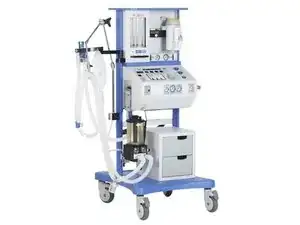Background and Identification
The Medec Neptune Anesthesia is a device used in hospitals by medical professionals. The primary use of the device is intended for inhaled anesthesia applications, but the device can also be used for ventilation if needed. It is equipped with special safety system technology, VoluProtect and BaroProtect, which helps reduce the risk of lung injuries during ventilation. Along with that, the machine also includes a balanced bag-in-bottle ventilator, which Medec was the first to introduce, with special technology to provide lung ventilation to patients.
The device is available globally across 100 countries and is developed and manufactured at the base factory in Aalst, Belgium. It’s intended user group is for patients of all ages, from neonates to adults. With various software upgrades since it was first released in 1985, the machine software is available in many different languages.
The Medec Neptune Anesthesia has a slim and modular design that is a standard blue and grey color. The ventilator has a 6-inch monochrome display to show pressure wave form and LED displays surrounding it to show other measurements. The machine has a top shelf with a vital sign monitor and at the back there are two gas-cylinders that can be fit into the trolley. It has an integrated airway suction system attached to the side of the trolley.
Technical Specifications
Capnography (Concentrations and partial pressures of gases):
- ETCO2: Partial Pressure at the end of Expiration
- PECO2: Mean Expired CO2 Partial Pressure
- VD/VT: Ratio between the Serial Dead Space and the Current Volume
- Va: Alveolar Volume of Each Breath
- Vd: Serial or Anatomical Dead Space Volume of each Breath
- VTCO2: CO2 expired Volume per Breath
Pneumonic System Data:
- Cylinder holders: 2 holders for 10L bottles
- Drawer unit: 2 drawers incorporated
- Shelfs: 1 monitor shelf
- Pipeline inlet pressure:
- O2 (3-8 bar)
- N2O (3-8 bar)
- Air (3-8 bar)
- Manometer gauges:
- O2 (0-10 bar)
- N20 (0-10 bar)
- Air (0-10 bar)
- Absorber features: Safety overpressure valve at 100 cmH2O (autoclavable)
- Oxygen flush: 40 I/min (between 3-8 bar)
- Rotameter: 3 gases – 4 tubes
- O2 tube (0-1 I/min) and (0-10 I/min)
- N2O tube (0-12 I/min)
- Air (0-15 I/min)
- Vaporizers: Flow and temperature compensated
- Suction: Built-in, operating on vacuum
- Manometer gauges regulator:
- O2 (0-250 bar)
- N20 (0-100 bar)
- Volume of CO2 absorber: 1, 5 L
- Optional regulators: Built-in regulator for O2 – N2O
Ventilator (Bag-in bottle system) Data:
- Tidal volume (Continuous Mandatory Ventilation - CMV): 10-1500 ml
- I:E ratio (breath cycle proportions): 1:1, 1:2, 1:3, 1:4, 2:1, 3:1
- Sigh: On – Off
- Lower pressure alarm limit:
- 2 mbar – 94 mbar (CMV)
- 2 mbar – 58 mbar (Pressure Control Ventilation – PCV)
- Measured parameters: Expired tidal volume, frequency, minute volume, peak inspiratory pressure (PIP), plateau pressure, positive end-expiratory pressure (PEEP), mean pressure, patient pressure
- Battery type and backup: Sealed lead acid battery; Minimal 2 hours when fully charged
- Humidity: 0-95% RH non-condensing
- Ventilation modes: CMV, PCV, manual, spontaneous
- Peak pressure (PCV): 5-60 mbar
- Peep (electronic): 0-20 mbar
- Plateau time: 0-50%
- Low oxygen alarm limit: 18-98%
- Alarms: Low air/O2/N2O input pressure, Apnea alarm, O2 alarms, upper/lower limit alarm, leak or patient disconnection, and user and technical alarms
- Operating voltage: 100-240V, 50-60 Hz
- Operating temperature: 10-40 degrees Celsius
- Ventilation frequency: 4-60 breaths per min
- Trigger: -2 to -20 mbar
- Upper pressure alarm limit: 7 mbar to 99 mbar
- High oxygen alarm limit: 18-98%
- Other display readings:
- Silent indicator
- Time & Date
- Mains and Battery indicator
- Power consumption: <100 VA
- Storage temperature: 5-50 degrees Celsius
Source: M. Belenux nv. (2020). Neptune Anesthesia Workstation. Medec International. https:// www.mediset.cz/obrazky/anesteziologie/medec/Neptune_angl.pdf
